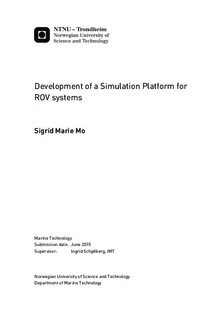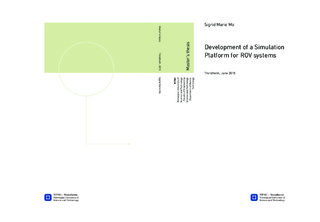| dc.description.abstract | ROVs are frequently used in subsea operations, both in the oil and gas industry, by scientists and in aquacultures. The ROV missions are normally controlled by a human operator, and the results are highly depending on her/his experience. A more predictable and independent operation can be achieved by introducing autonomy. When testing and verifying control algorithms for such an operation, a simulation environment can be a very helpful tool.
The objective in this thesis was to start the development of a simulation platform that can be used when developing and testing control systems for ROV operations. The platform will consist of two main parts; one simulator and a control system. The simulator part will include a dynamic model of an ROV in addition to sensor models. The control system will include an estimator, a guidance system, a path planner and a controller. The platform must be module based, such that users can implement their own algorithms easily and get immediate simulation results without needing to implement a complete control system. There should also be an easy transition between testing the control system on the simulated ROV and applying it to the real ROV.
The frameworks ROS (Robot Operating System) and MORSE (Modular OpenRobots Simulation Engine) are used in the development of the platform. ROS provides software management and communication protocols, while MORSE provides dynamics simulation with collision detection and implementation methods for 3D visualizations of the simulated vehicle.
A dynamic model of an ROV is implemented in both ROS and MORSE, and an evaluation is done to make recommendations for which model that should be used in the simulation platform. Two controllers, two guidance systems and one path planner is designed and implemented in the platform to test and verify the methods used for software communication.
The dynamic model implemented in ROS has proven to give realistic simulation results, but it is not able to simulate collisions. The dynamic model implemented in MORSE is able to simulate collisions, but it has other issued that needs to be fixed before it can be used in the simulation platform. The main issue is that MORSE is not able to process information received from the control system fast enough to do simulations in real time. There is also an issue with the inertia of the simulated vehicle, which makes the vehicle react too fast to thrust forces.
It is concluded that MORSE should be used in the further development of the platform. Although the dynamic model implemented in ROS gives better results for now, MORSE is found to have a greater potential as it provides collision detection and multiple sensor models. | |

